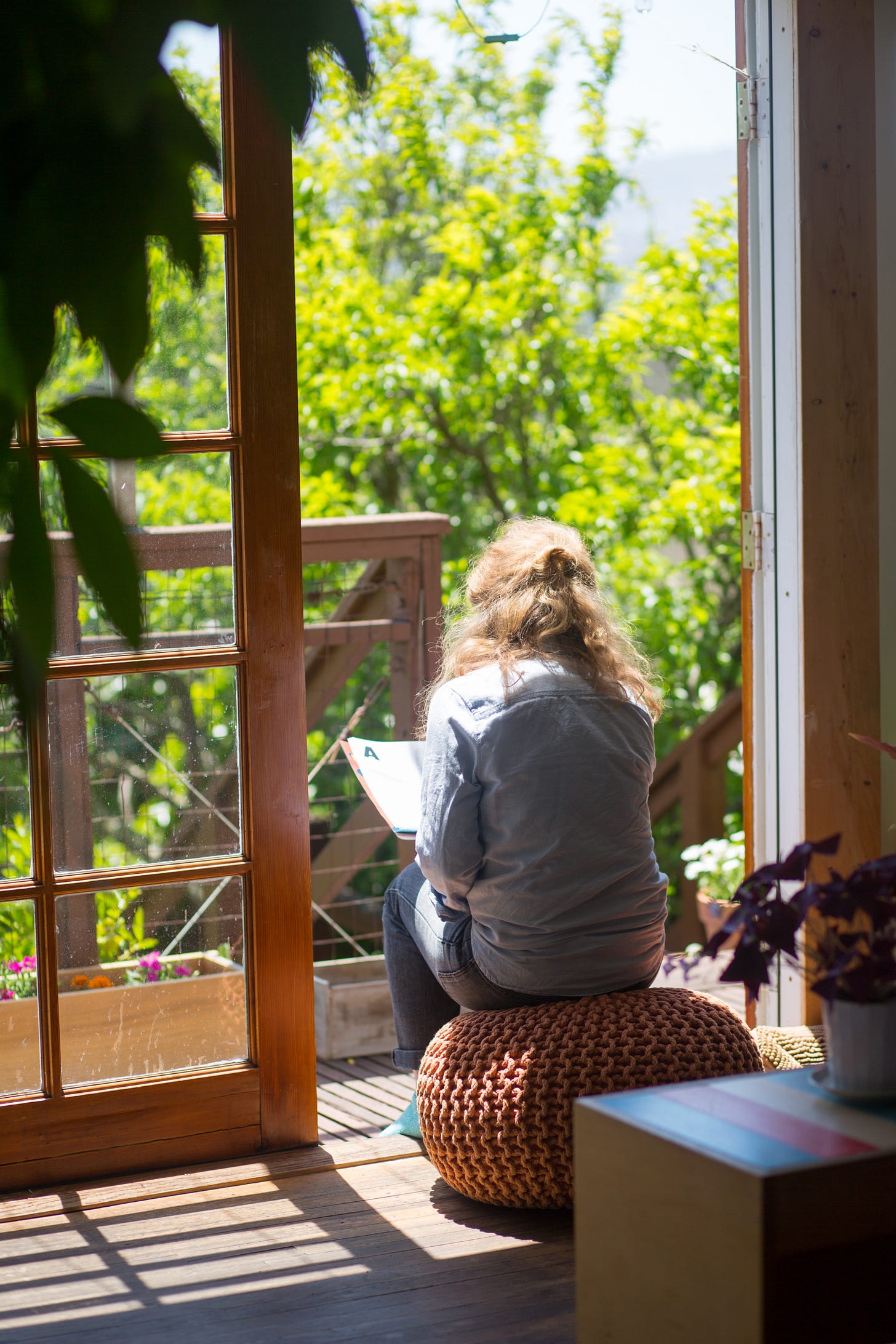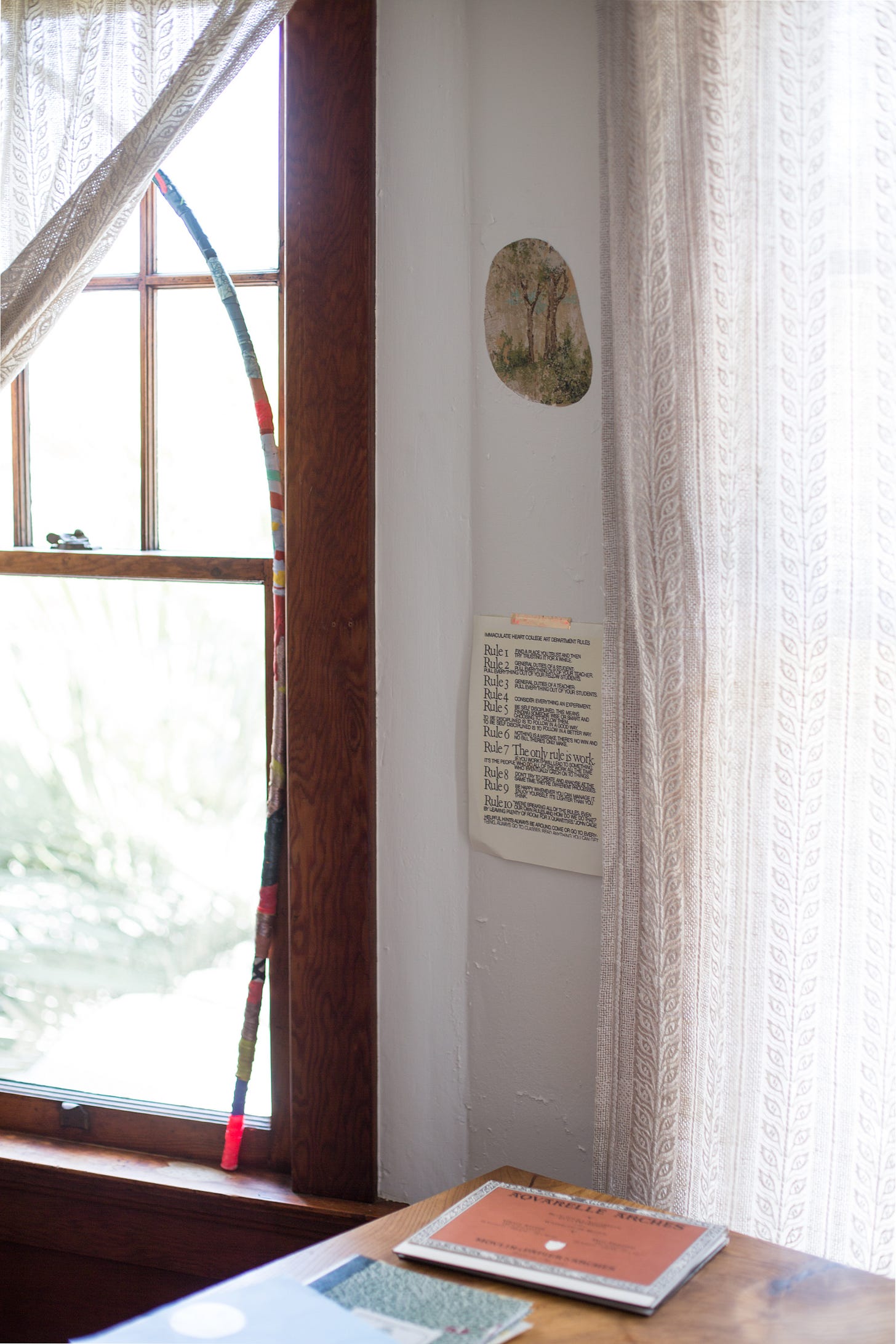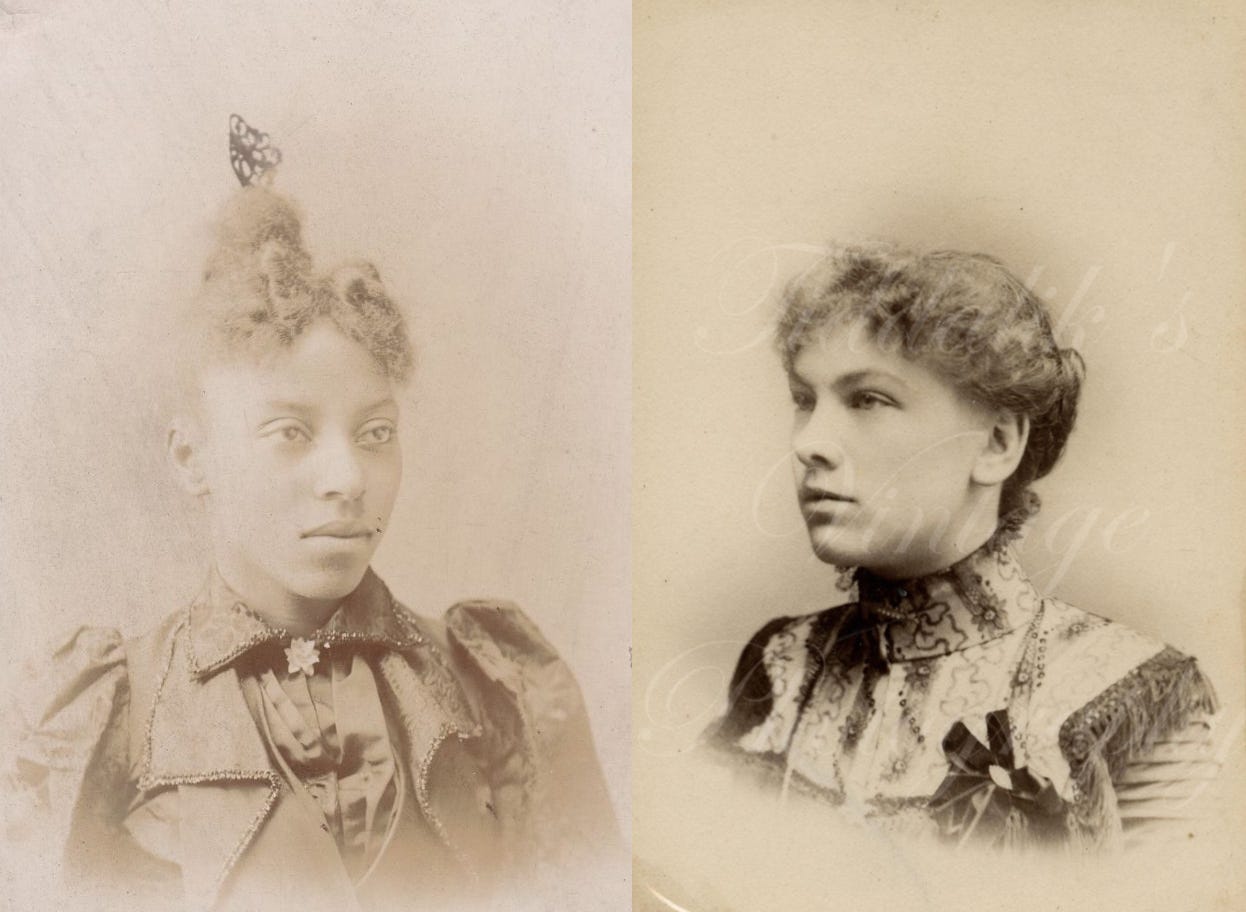At home in San Francisco, California with Leah Rosenberg
"The ability to make things in a home I feel safe in has been medicine at a time of loss, isolation and confusion, a gift."
Good morning,
This month’s issue of REALM features an interview and home-tour with artist Leah Rosenberg, a dear friend of mine. Leah’s shared home in San Francisco has been an epicenter of gathering, feast and community for many years. She is a master of creating vignettes in three dimensional spaces, particularly in kitchens and on tabletops; visual, edible arrangements that balance mess and ease with bounty and beauty. Perhaps related to her background (and her precision) as a painter and a pastry chef, Leah has honed her ability to create tight visual fields, or vignettes. However, because her endless installation work keeps her on the move, her work is the converse of fussy: it shifts, melts, hardens, crumbles, and is always welcoming, often reminding us of childhood play and of our under-appreciated senses of taste and touch.
Leah’s work as an artist is based on her pursuit, documentation and application of color, color that is found via chance encounters, generally through walking in everyday environs. Perhaps colorblind in a past life, and making up for lost sensing, Leah’s work draws us all into the associations and residues of the infinite hues pulsing silently around us.
Leah’s home always feels optimistic and generous. Her work is similar, folding together urban exploration, culinary endeavors (especially cake), endless gifts, minimalist painting, oddball ephemera, stark sculpture, whimsical video, sculpture and site-specific installations, using any medium to draw attention to the meaning and delight of flavor and color. She’s even published a book encouraging a polychromatic scavenger hunt, created color legends through historical sites like Ghiradelli Square and updating the palette of contemporary spaces like SFO International Airport. Leah’s continually changing tableaus are from and for living with; much of her work has interactive components; there is always something to touch, eat, or to otherwise stimulate. Her playful objects or installations often take on increased physicality over time, in a state of continual becoming.
Because specific geographies are often the starting point to Leah’s projects, her work has historically kept her from being home for more than a month or two at a time. When the pandemic started, she found herself rooted, at home nonstop for the first time in years. I wondered how this rooting altered her relationship to home and domesticity. I asked Leah about her daily routines since this slowing, why she’s still giving things away, what objects matter most to her, about hosting, collecting, and of course, color and its influence on her mood and life.
Just one week after photographing Leah’s home, she was informed its owner was selling and would be sending realty photographers over to document every room. When I looked at the same spaces I’d photographed only days prior, now on Redfin, I saw sharp edges that barely resonated, everything fish-eyed and dead-eyed. Despite the lack of time to tuck away any personal items when unknown photographers came by, these for-sale images were utterly un-intimate while managing to be remarkably invasive. A distanced eye is one that sees all and knows nothing, panopticon style. What became immediately clear to us both is that how we look at something changes what we see.
Enjoy the interview and images of a longstanding home, just before it’s dismantled, with the poetic and whimsical Leah Rosenberg.
Hello Leah! What is your home-aesthetic in 3 phrases?
Inviting; lived in and full of life; not precious.
You’ve been renting the same house in Bernal Heights for nearly fifteen years, since I’ve met you, and I’m curious how you answer the question “who do you live with?”
A rotating group of friends and colleagues, artists and curators, writers and teachers.
Tell me about your most beloved object at home, and why you’re taken with it.
The long table; it feels like the house was built around it. I made a rainbow rubbing of the long dining table as a tribute to all the guests we have had around it, the food served and projects realized upon it.
What things affected you most poignantly about the home you grew up in?
The golden raspberry bush that lined the back fence; thorny but worth it. Long winters holed up in the basement making art; cold but creative. Dressing up in costumes, and making things for the model train that lived on an old ping pong table And wrapping up collected pine cones to leave on neighbors front steps as "pretty" surprises. Architecturally, I remember the pass through window cutout in the wall between the kitchen and the dining room.
What’s your version of domestic bliss?
Cooking for others; things growing in the garden; thriving houseplants. Baskets full of whatever fruit or vegetable is in season; assembling and arranging tiny bouquets around the house; art on the walls. Books in piles; poems pinned up; flurries of activity at all hours—all set to music. The light through the windows is everything! Tying back the curtains to let the sun pour into the house during the day. Turning the lights down low at night so the house glows through closed curtains.
Do you prefer collecting things or giving things away?
I love to give things. One of the books which I continually revisit is The Gift by Lewis Hyde. “A gift,” Hyde says, “must always move.” By ritually returning to this book, showing up day after day to make art, and then setting the art free into the unpredictable opinions of the world, I’ve learned gifts not only transform us, but they also compel us to pass them along.
If you lived alone, what major change would you finally get to implement?
Maybe play music louder in the morning? Take more baths at night? I have yet to know!
What are your kitchen routines, your must-do’s and your never-do’s?
Every morning starts with drinking water out of a jar while looking out the window above the kitchen sink. I visit the fridge fairly often to note and contribute to changes in its contents. You must temper your ingredients and preheat the oven before baking a cake, empty sardine cans directly to outside receptacles, break down your boxes. It takes five seconds to do the right thing. Or, a pinch of Maldon Sea Salt.
What do you think homes of the future will be like?
That everyone can have one and have access to a garden. Communal, open, less cords, more time together in conversation pits. Home of the future will be easier to be less wasteful in.
How are you affected by color or a lack of color in your domestic realm?
It’s hard for me not to see color. I see it in everything. The food that we prepare, on the bookshelf, in my closet, in the garden. The light is pink in the morning, and blue in the afternoon. I grew up in Saskatoon, Saskatchewan, and the open sky against the bareness of the prairie landscape was the canvas for my imagination, planting the seeds for what I do now.
If your bedroom could look more like one of your favorite painters works, what painter would that be?
If I had to pick one—Agnes Martin. If I could, I’d have one wall for Blinky Palermo, one wall for Imi Knoebel, one wall for On Kawara and one wall for Ann Truitt.
What have you done at home that you’d confidently recommend to others?
Make a copy of your house key.
How has the town you live in influenced your life inside your abode, and do you have any philosophies about living that are manifested in the realm of home?
This past year was the first year I really lived here because I moved my studio home, planted a flower garden and did not travel. The garden outside became my subject, an engine of creative cohesion. I made lemon curd with the lemons and preserved the plums in ways more than one, chronicled daily blooms in a stripe painting. In this process of caring for the house, the house started caring for me. Such reciprocal care is what it means to be an artist continuing to live and work in the Bay Area and is how we keep the gift moving.
If you had to leave quickly in a fire and grab only a few armfuls of things, what would you take?
I’d be lying if I didn’t say my phone/laptop. How did we get here? The shoes on my feet. An afghan my mom made for me—grey with a green stripe. The potted purple oxalis and water.
If you have a nickname for your home, what is it?
IDA: Institute for Design Analysis
What are you most grateful for about your home?
The ability to make things in a home I feel safe in has been medicine at a time of loss, isolation and confusion, a gift. I reaped what I grew, embellished cakes with flowers, flavored recipes with herbs, and strung strawflower into festoons.
Do you prefer to maintain the house arrangement as it is or vary it often?
I like to make changes. Every so often we do a big switch-a-roo. But mostly I just like rearranging the small things: swapping out flowers, moving a plant, decluttering.
What might you keep collecting throughout your life? If you had to give away this whole collection to someone tomorrow, who or where would you give it to?
Colors. And poems.
I like the idea of everything I’ve made (and not already destroyed) being pieces of a large “life's work” that everyone who wants can get a part of. But I'm not sure how many "pieces" I will be putting out into the world. I love when my work takes me to places with empty spaces that I can paint every day, one color at a time. And there is nowhere I would rather do that than at the Guggenheim, starting from the top of the rotunda, all the way down. I have it all choreographed already. All I need is the paint and the permission.
Describe your home in 5 words.
The place where everything happens.
Delving Deeper:
Find out more about Leah’s art and installations, how to get her 2022 confetti calendar or simply follow her rainbow-brick road @leahmartharosenberg.
If you’re in San Francisco anytime from now through mid-January, stop by the first floor of the SFMoma, where, without any entry fee required, you can view Leah’s Getting Better Everyday a Color, an in-process mural. The project is concordant with the kind, generous work of Susan O’Malley, a late Bay Area artist whose text-based works are in the concurrent exhibition One Day at a Time. Leah and Susan’s work, and their friendship, is an uplifting and poignant reminder of the ways art can help us heal and honor that which influences our lives for the better, daily.
Etymology Interlude
Vignette (noun) meaning “decorative design” or “a short written description.”
From 1751, from Old French, based on ‘vigne’ an offshoot of “vine” or “vineyard.”
On the pages of antique French books there tends to be delicately drawn tendrils of vines framing particular page edges, a way to mark a chapter head or a foreward. These drawn vignes led to the usage of the word ‘vignette’ eventually, meaning a literal sketch, or a literary sketch, both imbued with visual detail. Eventually, as the invention of photography arose, vignette also came to refer to any picture (especially portraits) with blurred, darkened or completely faded edges, a soft border.
Today, vignette has so many meanings it is almost borderless! From ‘a scene in a play or movie’ to ‘a short literary interlude or descriptive sketch’ to ‘a small decorative design or picture’ to (at least in my photographic world) ‘an isolated arrangement within an interior’ each interpretation started with decorative vines drawn at the edge of a book’s page. There is even such a thing as a ‘clinical vignette’ a concise, focused write-up about a trainees knowledge. Thus, to vignette something can be to give acute focus on what’s in front of you, excluding background or contextual information—a reframing of sorts.
Leah is a master of creating vignettes in a room: perhaps it’s in her roots as a painter, or due to her proficiency as a gardener, where tendrils overflow every which way. Most of us create arrangements in corners and spaces of our homes where a few items are combined; these are vignettes when they have a border around them—albeit a border made of vacant space, not of drawn grape-vines. An interior vignette does not bleed into the surrounding room but stands out as a focal point, isolated from other elements, similar to the falling-off of the visual field in the two Victorian portraits below, where background, the edges of coif and blouses, are unseen.
On that ghostly note, I’ll leave you, until next time.
Warmly,
Airyka
















